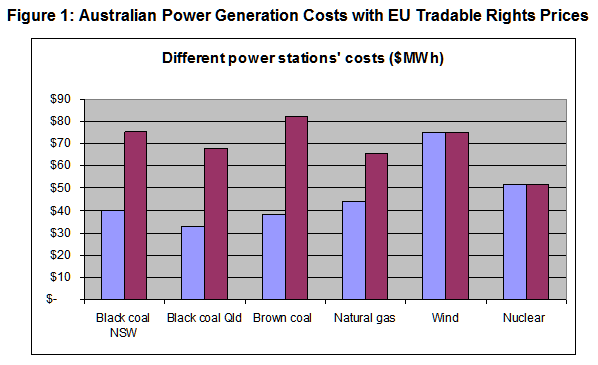WE may not be getting an emissions trading scheme any time soon but the climate and energy crises still need fixing with real urgency.
Applying the EU price of $41 per tonne of CO2, cost to current power sources would result in nuclear power becoming marginally cheaper than coal and natural gas generation.

For climate, the issue is excess greenhouse gases from burning fossil fuels. For energy, the crisis is dwindling supplies of those fuels and air pollution from coal combustion.
Replacement energy sources need to be reliable, plentiful and economic to deploy. They need to be low-carbon to minimise global warming. Business-as-usual or half measures risks saddling future generations with a climatically hostile planet and energy scarcity.
Nuclear power is one obvious replacement source, but typically raises five objections.
First, readily available uranium supplies are limited. If the world was wholly powered by present-style nuclear reactors there would be at most a few decades of energy before cheap uranium was exhausted.
Second, nuclear accidents have happened in the past, suggesting this technology is dangerous.
Third, expansion of nuclear power would risk the proliferation of nuclear weapons.
Fourth, we would leave future generations with the legacy of long-lived nuclear waste.
Fifth, large amounts of energy (and possibly greenhouse gases) would be required to mine, mill and enrich uranium and to build and later decommission nuclear power stations.
All the above points have merit, although their relative importance comparedwith climate change and critical energy shortages is debatable. But there is little point in debating these objections because none will apply to future nuclear energy generation.
Almost all today's nuclear power stations are thermal reactors. These use water to slow the neutrons that cause uranium atoms to split (fission) and to carry the heat generated in this reaction to a steam turbine to generate electricity.
Because of the gradual build-up of fission products (neutron poisons) through time, we end up getting less than 1 per cent of the useable energy out of the uranium. The rest is thrown out as that long-lived waste.
In contrast, newer fast reactors are able to use almost all of the energy in uranium. There is enough energy in already mined uranium and stored plutonium from existing stockpiles to supply all the world's power needs for more than three centuries before we need to mine any more uranium.
Fast reactors can be used to burn all existing reserves of plutonium and the nuclear waste from the past and present generation of thermal reactors. With additional uranium mining, there is enough energy in proven deposits to supply the entire world for many thousands of years. This deals with the first objection.
As to the second objection, modern reactors use passive safety systems requiring no operator intervention to shut down the reaction. This makes them safe. So safe that a certification assessment for Westinghouse's AP-1000 reactor put the risk of a core meltdown such as the one that occurred at in the US in 1979 at Three Mile Island at once every 24 million reactor years.
Comparing the flawed Chernobyl design to today's reactors is like saying modern aviation is too dangerous because the Hindenburg airship exploded in 1937.
On the third objection, proliferation, the nuclear fuel used by fast reactors is initially very radioactive, making it impossible to divert to a nuclear weapons program without an expensive, heavily shielded, off-site reprocessing facility that would be readily detected.
In fact, the only nuclear waste materials that will ever leave an Integral Fast Reactor complex (which has on-site recycling) are fission products, which decay to background levels of radiation within a few hundred years.
Unlike conventional nuclear waste, which can last for hundreds of thousands of years (the fourth objection), the waste from IFRs can be more readily stored because of its small volume (150 times less than used nuclear fuel from thermal reactors) and short storage times.
The fifth objection, concerning greenhouse gases generated in building nuclear power plants, has never stood up to detailed life-cycle analysis.
Renewable energy sources (such as wind and solar) use significantly more raw materials per unit of energy generated than even present-generation nuclear power stations and the full life-cycle emissions, including nuclear fuel production, are similar from both sources. When energy storage and fossil-fuel back-up are included, wind and solar emissions are much higher.
A possible sixth objection could be that we don't need nuclear power when we can use renewable energy. This is a valid objection for countries with abundant hydropower, conventional geothermal power or biomass, the only three renewable sources of proven reliable power that can deliver energy 24 hours a day at an acceptable cost. Solar and wind sources, however, still rely heavily on fossil fuels to deliver reliable, continuous energy.
At today's pace of commercial development we won't see many fast nuclear reactors delivering power to the grid before 2020. This will seem too late for some, but at the present pace, non-hydro renewables will only meet 2 per cent of global energy use.
Either option, therefore, requires radically accelerated research, development and deployment if it is to make a difference to climate change and energy supply. What's required is a project of Manhattan-style proportions or the audacity of the moon-shot vision.
Let's be clear. We have the means to fix the climate and energy crises, or at least avert the worst consequences. New generation nuclear power, supported by an expansion of the thermal reactor fleet, is one possible path to success and one that all nations should support. Rationally considering energy planning requires letting go of old-school thinking about exciting new technologies.
Martin Nicholson is the author of Energy in a Changing Climate. Barry Brook is professor of climate change at the University of Adelaide's Environment Institute.

 Australian Uranium News - Research
Australian Uranium News - Research












